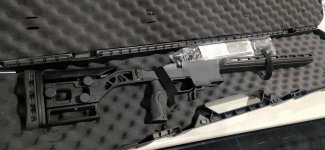Tagging in, I love the idea
Op, don’t get discouraged. Just know that a project like this is going to take a minimum 4x longer than you anticipate. Keep at it and please update with your progress
4x ? Wow, your optimistic.
It goes like this.
1: work out what sort of market you want to fulfil, or what sort of product you want (hunting, rimfire, ELR, PRS, whatever).
2: market research to determine if the product you propose is viable. "Is there a hole to fill".
3: cost evaluation as a result of point 2. Development time, prototype time, lead time to market, etc.
4: start making prototypes within a budget. You don't exactly make a "full bells and whistles" as a first run (usually). 3d printing is awesome here. As is half size, if possible. Gives you a good scale of things, what will work, what won't, things you have already found before running a machine.
5: feedback. Get reliable people to give feedback. And honest feedback. Not to shit on your idea. But often things like "I do night shooting, can I run a super long pic rail without hitting that thing there ?" Or "I'm a hunter, where's the sling points ?". Even "it's too heavy for fclass, you need to get it under X kg to make it viable, also need weight out of here and put here to work for us".
6: refine your next prototype with info you have, also remember the costing of things. You don't want to make 10+ trial prototype as your budget will be dead, and you don't want to rush to market an incomplete job. It's a REALLY fine line. Often why many parts never see the light of day. The bean counters shut the project off as it cost too much to develop.
7: retail price point (partly point 2.5). If you made 4 prototypes, and you want $10 profit on each item, you expect a 100 product life cycle, and your retail point is $100. Do some math.. you need to produce the product for about 50% of retail, roughly. Factor in packaging, marketing (stickers, sponsorship, give away, etc) plus rework on parts (say a machine breaks a cutter, so you have a dead part, or someone paints the part the wrong colour, etc) and RMA Warr. Don't forget hardware you buy, like screws, or grips, or recoil pads.
The first chassis that imaginary company retails for $1000, is probably a $10k chassis. They need to sell 500 before they even break even, let alone start paying development costs or suppliers.


